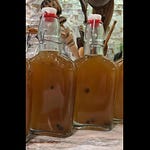Welcome to The Simmering Chef.
Cooking with a smidgen of anger, a pinch of crass, a dollop of irreverence, a sprinkling of science, and a handful of spice.
Thank you, everyone, for listening today. I am so happy you are here.
This week’s query is from my own old hometown of Los Angeles, asking about quiche.
Dear The Simmering Chef,
One of my favorite things to make for dinner is a quiche. I love it because not only does it make a nutritious dinner, but there are also several excellent cold lunches when I pair it with a fresh salad. It comes from the oven gorgeously brown and puffy when I bake it. As it sits, I watch it deflate and become sad-looking. Is there anything I can do to help keep it looking beautiful?
Quiche Eater in Hollywood
Dear QE,
Oy! If no one has told you, you are Sisyphus, constantly trying to roll that rocky quiche up a mountain that simply wants to roll down and flatten your dreamy plumpness into collapsed coagulation.
Eggs are your nemesis here, and it’s not like they are out to get you. It’s nothing personal. It’s just PHYSICS. Luckily, you can make them work for you instead of against you, and planning is key here.
As we’ve touched on in previous episodes, eggs add structure and moisture to bake goods. Because we know that anything that steams expands, it also means that when it cools, it retracts. Hence the deflation you’re seeing.
Here are the things you need to do.
Adjust the filling mixture with an additional fatty yolk because egg white is 90% water. When it is heated over 212°F, water becomes steam.
Be sure to precook and cool your veg before layering onto the crust. That cooks out that extra water. Sisyphus works hard enough, so help the dude out and not make his job harder!
Use heavy/whole cream. The higher fat content reduces steam and any rubberiness during baking because eggs like to turn rubbery if cooked too hot. If you want to go full-on renegade, use cream cheese. And here’s another fun trick. Blend the ingredients in your blender. This really mixes everything up AND adds a little additional air.
Cook at a lower temperature. Your recipe might say bake at 350 to 375°F., which is excellent for cooking that crust but awful on the eggs. Par-bake your crust, and once it’s par-baked and cooled, brush it with a bit of real French Dijon mustard. You know, the really spicy kind that’ll clear your nose. That seals the crust, preventing seepage, a soggy crust, and steam. It also adds a je-ne-sais-se-quoi flavor that people crave. We all want a little bit of that in our lives, now don’t we? Next is to bake it at a lower temperature, say 300 to 325°F. Sure, it takes longer, but that time helps the finished quiche stay plump and tender.
Now, there is an additional trick that’s truly old-school. Still, I advise caution because salmonella runs rampant in the American commercial egg industry. Here it is. In the beginning, reserve some of the egg mixture, maybe 10 to 15% of it, instead of pouring it all into the quiche shell. When the quiche has baked three-quarters of the way, remove it from the oven and make a small hole in its center. Gently pour the remaining raw egg mixture into the hole and return it to the oven to finish baking. What you are doing is, by adding the liquid mixture to the cooked, you are forcing the baked structure to plump out. The problem is you might not be cooking those eggs thoroughly enough to kill any salmonella that might be present. Remember, salmonella is killed at 167°F when the item is baked for 10 minutes. That timing is far too long to add a raw egg to a quiche already cooked three-quarters of the way. There’s a chance the “plumping” egg mixture might not stay in the oven long enough to kill off those bacterial meanies.
There you have it. Hope the advice helps. At the bottom of today’s transcript, you’ll find a recipe for my Onion Quiche with a Gluten-Free Crust. Enjoy!
As always, if you have questions, please ask.
Before we leave each other today, here’s a little shameless plug encouraging you to subscribe to The Simmering Chef on Substack. My subscribers receive a non-habitual culinary communication focusing on a seasonal fruit or vegetable with a corresponding recipe, information, and hopefully a little humor. Look for it in the spam folder because, in all honesty, that’s precisely where it belongs.
Thank you so much for listening! As always, fail brilliantly and eat well.
The Simmering Chef
ONION QUICHE with a GLUTEN-FREE CRUST
INGREDIENTS
GLUTEN-FREE CRUST
2 Tablespoon golden flaxseed meal
⅓ cup hot water
1 cup millet flour
¼ cup quinoa flour
⅓+ cup brown rice flour
⅓ cup cornstarch
½ teaspoon salt
½ teaspoon dried thyme
8 Tablespoons unsalted butter, grated and well-chilled
3 to 4 Tablespoons of water
1 Tablespoon Dijon mustard. The spicier, the better.
FILLING
1 ounce unsalted butter
1 ounce bacon fat or lard
1 Tablespoon extra virgin olive oil
1 pound yellow onions, finely sliced pole to pole
1½ pounds of sweet onions, finely sliced pole-to-pole
1½ Tablespoons gluten-free flour, but not a nut flour
2 ounces bacon, diced
2 large eggs
1 egg yolk
⅓ cup heavy cream
3 ounces cream cheese
1 teaspoon salt
¼ teaspoon black pepper, freshly ground
¼ teaspoon cayenne
A whisper of nutmeg, freshly grated
2 ounces Gruyère, shredded
METHOD
CRUST
In a small bowl, whisk together the flaxseed meal and warm water.
Let it rest for 15 minutes.
You will see this turn gelatinous.
Set aside and make your crust.
In the bowl of a stand mixer, combine your different types of flour, cornstarch, salt, and dried thyme.
Use the paddle attachment and gently mix the dry ingredients together.
Add the flaxseed meal mixture.
Beat on medium speed.
Add the butter and beat until crumbly,
Gradually add the water until the dough forms a ball.
This will be on the sticky side.
Dust the dough with rice flour.
Shape into a six-inch circle.
Place on a sheet pan and cover.
Refrigerate for 60 minutes.
Before rolling out, allow the dough to come to room temperature for 10 minutes.
Follow the directions below on how to roll out the dough.
FILLING
While the dough chills, cook the onions.
Heat butter, fat, and oil in a heavy-bottomed skillet.
Add onions and cook over medium-low heat until a pale golden brown and all the water has evaporated.
This could take up to an hour, and you will need to stir occasionally.
Stir in the flour and cook another 5 minutes.
Remove from heat.
Butter a 9-inch tart pan.
Remove the chilled dough from the plastic wrap.
Place on a floured surface and roll out into an 11-inch circle.
Drape it over the tart pan and press down to get it into the edges and sides.
Remove any excess dough by rolling a rolling pin over the top or cutting away the extra dough with a knife.
Use your fingers to push the dough a ¼-inch above the pan’s edge,
Dock the crust.
Chill for at least 30 minutes.
Pre-heat oven to 400°F.
Place the chilled tart dough onto a baking sheet.
Line with foil.
Fill with dried beans or pie weights.
Bake for 15 minutes.
Remove the tart crust from the oven and remove weights and foil.
Return to the oven and bake, uncovered, until the crust is dried out and just starting to brown around the edges.
Remove from the oven and place on a rack.
Cool to room temperature.
Brush the bottom with Dijon mustard.
Reduce oven temperature to 325°F.
Cook bacon to crispy and set aside to drain.
Mix the eggs, egg yolk, heavy cream, cream cheese, salt, pepper, cayenne, and nutmeg in the blender.
Blend to smooth.
Stir in the onions and half of the Gruyère into the egg mixture.
Scatter the bacon over the bottom of the par-cooked crust.
Pour the onion and egg mixture over the bacon.
Swirl the mixture with a chopstick to help the ingredients evenly distribute through the egg mixture.
Scatter the remaining Gruyère over the quiche.
Bake in 325°F oven for 35 to 45 minutes or until the quiche slightly jiggles when shaken.
It should look puffy and nicely browned.
Remove from the oven and cool slightly before removing the tart ring.
Slice the quiche into a cooling rack.
Serve warm or at room temperature.















Share this post